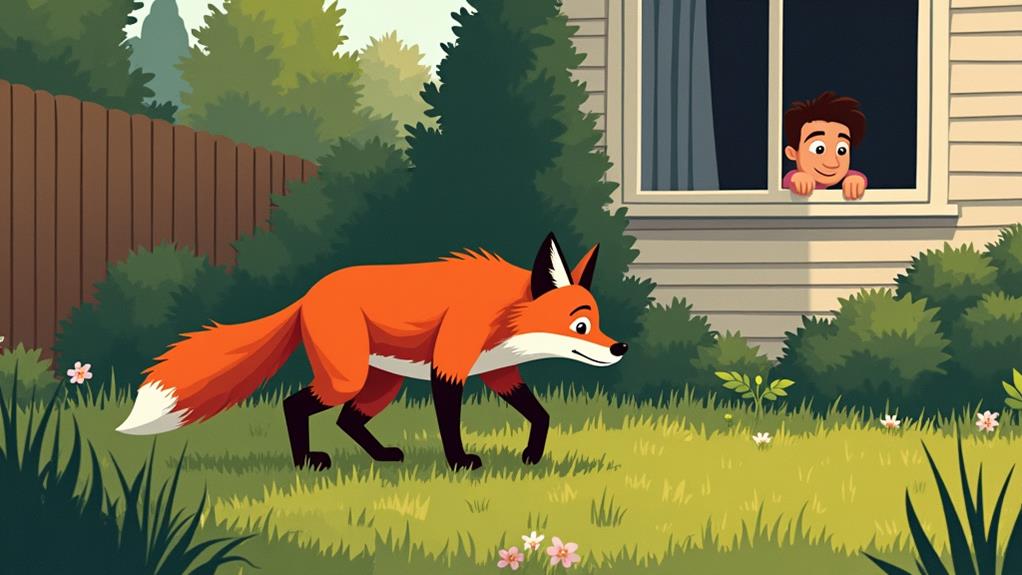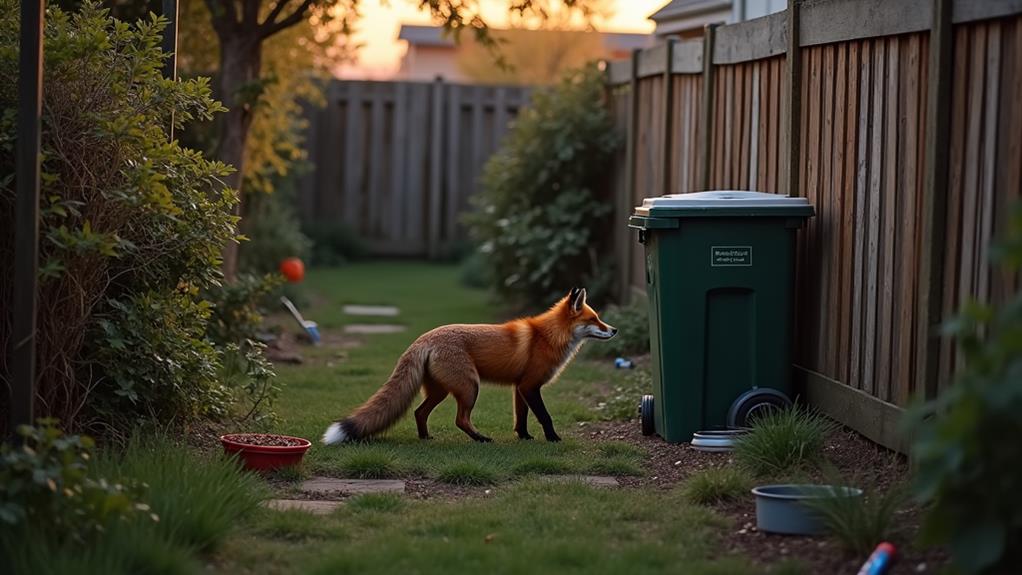If you see a red fox in your yard, stay calm and assess the situation. Keep your distance; observation is key! Avoid startling the fox; using gentle claps can encourage it to move along. You should also secure food sources—make sure garbage cans are sealed tight and keep pet food indoors. Protect your pets by supervising them closely, especially small ones like rabbits. If the fox looks sick or aggressive, it's best to contact local wildlife authorities for help. These adorable visitors can be fascinating, and there's more to know about how to handle them safely!
Contents
Assess the Situation Carefully

When you spot a red fox in your yard, the first step is to assess the situation carefully. You might find this clever creature simply passing through, enjoying a stroll as much as you do.
Red foxes are known for their remarkable adaptability and can thrive in both urban and rural settings, often seen in parks and gardens, which signifies their comfort in human-influenced spaces their adaptability to various settings.
Keep your distance and observe its behavior. If it looks calm and unbothered, it's likely just on its way. However, if you notice signs of illness—like staggering or excessive itching—pay close attention. These could indicate that something's wrong.
Don't forget to check for any kits nearby! During breeding season, it's common for foxes to be in your yard when moms are looking after their young.
In this case, steer clear and don't approach the fox directly. Approaching might make it feel cornered, and that's not a good situation for anyone involved.
If the fox seems bold or frequently visits, consider gentle, humane ways to encourage it to relocate. You want to help this furry friend find a safer space without causing harm.
Maintain Distance and Observe
Maintaining a safe distance while observing a red fox is essential for both your safety and theirs. These shy creatures are naturally curious, but they'll quickly retreat if they feel threatened.
Urban foxes often thrive in residential neighborhoods, utilizing gardens and parks for their foraging needs, making this a common sighting in urban areas. Stand back, avoid startling them, and instead, enjoy this remarkable moment from a safe spot, like a window or your porch.
When you observe, keep your movements calm and quiet. Avoid direct eye contact, as this can be perceived as a challenge. If the fox seems a bit too bold, a gentle clap or a soft shout can encourage it to move along without causing a fuss. It's all about keeping the vibe chill!
Now, as tempting as it may be, resist the urge to feed these clever animals. While they might look cute and approachable, feeding them can diminish their natural fear of humans and lead to dependency on our food.
Urban habitats support their survival, which might encourage a fox to see your backyard as a buffet!
Secure Food Sources

Securing food sources in your yard is essential to keeping red foxes at bay.
It's important to remember that red foxes are highly adaptable and may venture into urban environments searching for easy meals, especially when natural food sources are scarce.
Here are three important steps you can take:
- Store garbage properly: Make sure your outdoor garbage bins have tight-fitting lids. Foxes are clever scavengers, and if they smell food scraps, you might find a fox den in your yard before you know it!
- Keep pet food inside: If you have pet food, don't leave it outside. Foxes often sneak around at dusk and dawn, hoping to snag an easy meal. Keeping food indoors helps prevent inviting them over for dinner!
- Clean the yard: Regularly check for fallen fruit and compost piles. These can serve as tasty snacks for foxes, and cleaning them up helps secure food sources in your yard.
Protect Your Pets
Protecting your pets from red foxes is essential, especially if you have small animals like rabbits or chickens. Red foxes may be attracted to gardens and yards where food sources are readily available, such as pet food or spilled seeds from bird feeders.
Diverse ecosystems provide ample food sources for red foxes. You wouldn't want your fluffy friends to become lunch! Start by securing their housing with fortified enclosures. This way, those sneaky foxes can't get in.
Also, keep your cats indoors, particularly at night. It's safer, and they'll avoid any close contact with foxes, which can be dangerous.
If you have small dogs, always check on them closely when they're outside and never try to leave them unattended. A curious pup might catch a fox's eye, and we definitely don't want that!
Regular vaccinations against rabies are important too; while it's rare, encountering a wild fox could lead to potential risks.
Contact Wildlife Authorities

Occasionally, you might encounter a red fox in your yard, and if it seems aggressive, sick, or unusually tame, it's important to contact local wildlife authorities.
These encounters can be quite common given the red fox's adaptability to urban and suburban environments, and diverse habitats they thrive in.
They're your best resource for handling this situation safely. Here's why you should reach out:
- Get Expert Guidance: Wildlife authorities can give you tips on how to manage the fox encounter without putting yourself or the animals at risk.
- Health and Safety Checks: If there's any chance of rabies or illness, they can send professionals to assess the fox's health and behavior.
- Responsible Management: Reporting sightings helps them monitor local populations and make sure everyone stays safe, including the fox!
Final Thoughts
So, if you see a red fox sneaking through your yard, take a deep breath. It's an opportunity to witness nature's charm up close, not a reason to panic. Keep your distance, secure your food, and look after your pets. And hey, if you're ever in doubt, call the wildlife folks—they're like the superheroes of the animal world. Embrace the moment, but tread carefully; after all, even a charming fox knows how to keep its own secrets!














